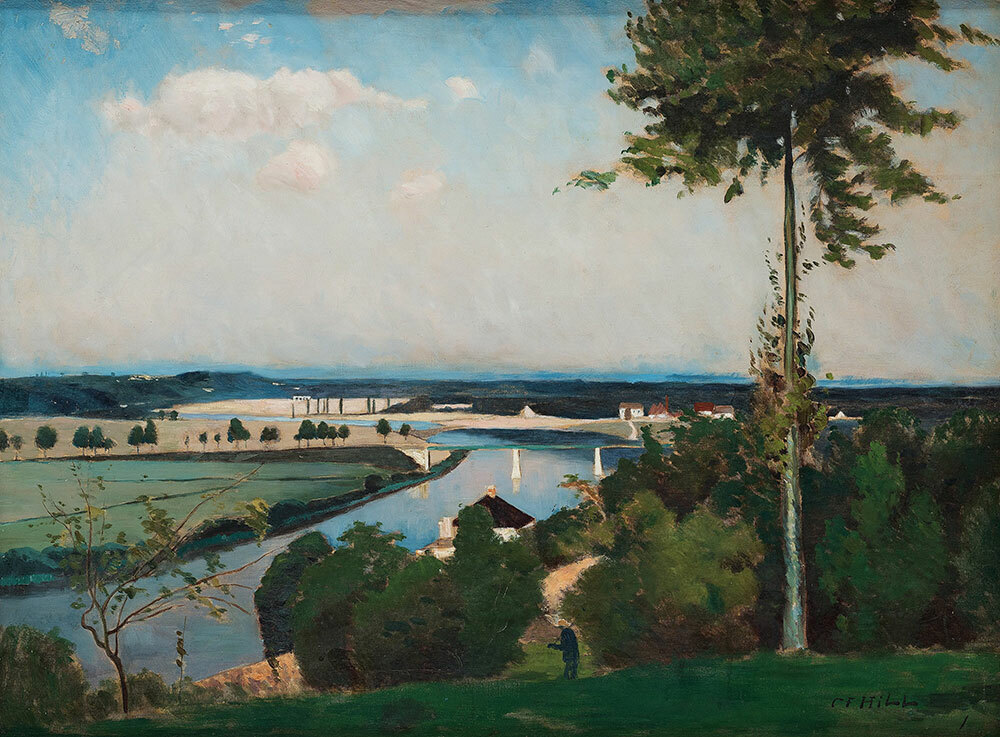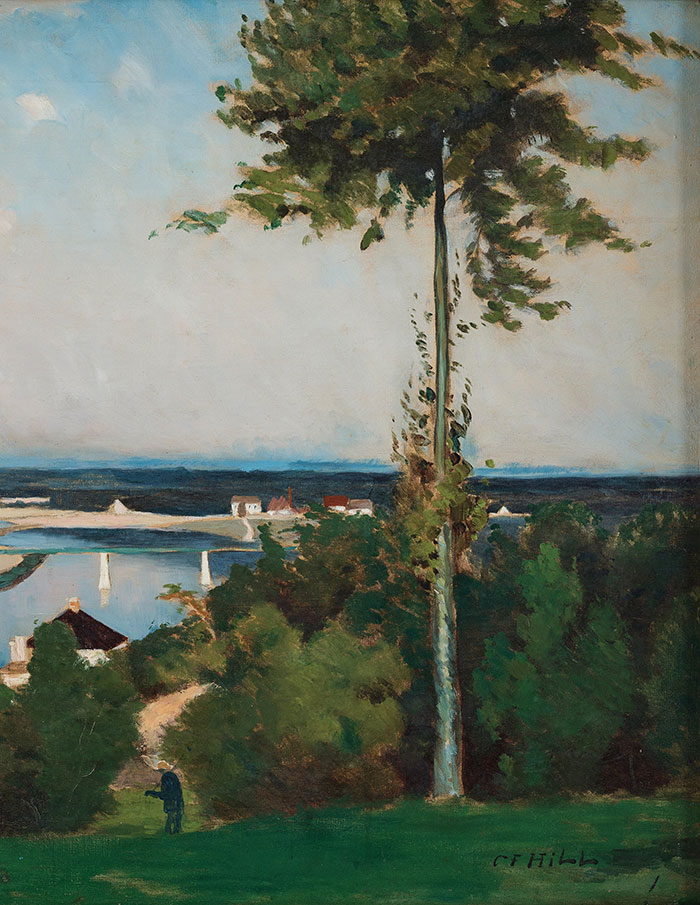New season – New Highlights: Carl Fredrik Hill 'The tree and the river bend'

Signed CF HiLL. Executed in Brolles/Bois-le-Roi in 1877. To be sold at Important Spring Sale 2 – 4 June. Estimate 8 000 000 - 10 000 000 SEK.
Carl Fredrik Hill 'The tree and the river bend'
This painting depicting the river landscape around Brolles / Bois-le-Roi is one of a handful of outstanding paintings which form the absolute culmination of Hill's spectacular oeuvre as a landscape painter in France. The composition was completed during the summer of 1877, barely six months before Hill was confined to Dr. Blanche's clinic in Passy after his nervous breakdown in the New Year 1878.
The spring and summer of 1877 proved to be unusually productive for the artist. After submitting two paintings (which were later rejected) to the prestigious Salon in Paris, Hill moved to the rural idyll southeast of Paris at the turn of the month March / April. With flowering fruit trees and a broad panoramic view of the Seine, this scenic area would inspire Hill to his now-legendary suites of thematically-linked landscape motifs.
In Nationalmuseum’s exhibition catalogue "Carl Fredrik Hill" (October 1, 1999 - January 16, 2000), Sten Åke Nilsson, professor of art history at Lund University, author of today's standard work on Hill ("Carl Fredrik Hill. Maximus Pictor", 2011), gives a summary of Hill's inspirational exhilaration during the intense production of 1877:
"It is surprising that during the moment of defeat, Hill could perform and complete so many works as he did this spring. When he celebrates his birthday on May 31, he had already finished 'a dozen flowering landscapes'; here, it is not the tide that set the limits but the short period of blooming. He also laid the foundation for the magnificent views of Chartrettes. 'Villa by the Seine' is now conceived along with the equally well-known series of paintings, called 'The Tree and the River Bend'. These have their viewpoint just above the villa. The close-ups of the fruit trees, which feel close and deeply personal, are balanced by the wide views of the Seine, which instead aim at the objective and universal".
This painting belongs to the above-mentioned suite of wide views of the Seine and has previously been exhibited under different, albeit often similar, names. At the Swedish-French Art Gallery in Stockholm, where it was shown in 1949, as part of director Charles Nilsson's collection, it was exhibited under the title "Landscape at Bois-le-Roi". Since Dr Adolf Anderberg published what would long be considered the standard work about the artist ("Carl Hill. His Life and His Art", 1951) the painting has generally been referred to as "The Tree and the River Bend IV". This name was used in the sale at Bukowskis in 1975 and also during Nationalmuseum’s extensive exhibition in 1999-2000.

The varying titles that accompanied the work highlight a problem regarding Carl Fredrik Hill's art. Usually, the artist seldom gave his own "official" title to his landscape paintings.
However, based on many years of work, new research now suggests that the catalogue number is to be regarded as the fifth motif (out of a total of six) in the famous suite "The Tree and the River Bend" from Brolles / Bois-le-Roi. The four motifs which, according to this reasoning, would have preceded the present catalogue number are;
— A painting (sketch) in the collections of Prince Eugene’s Waldemarsudde in Stockholm ("Landscape at Bois-le-Roi", oil on canvas, 21.5 x 27 cm, W 283, purchase by Prins Eugen 1925)
— A painting in the collections at the Nationalmuseum, Stockholm ("The tree and the river bend III [Bois-le-Roi]", oil on canvas, 50 x 60 cm, NM 1863, gift 1915 by art lovers through Richard Bergh).
— The large version, which, after being inherited within the artist's family, was sold for the world record auction price of SEK 15,125,000 at Bukowskis in December 2019 ("The tree and the river bend", oil on canvas, 80.5 x 99.5 cm, Åmells Konsthandel, Stockholm)
— A painting in the Gothenburg Art Museum collections ("French river landscape, Bois-le-Roi", oil on canvas, 54 x 73 cm, GKM 0522, purchased in 1915).
The remaining sixth version would then be a painting in the collections at Sven-Harry's Art Museum, Stockholm ("Trädet och flodkröken II", oil on canvas, 65 x 100 cm, previously in Professor Gustaf Petrén's collections, Lund, later purchased via Sotheby's, 1991, transferred from Folkhem Art Collection), which, probably, was executed after the present catalogue number.
The consequence by which Hill captured the motif in the first three versions (where format and composition show striking similarities) speaks partly for the order but also for the fact that he, in the end, reached the "final" version which he intended to submit to the prestigious Salon in Paris. In the final version, the canvas is the largest in size and has a next to square shape where the bushy tree crown on the foreground's stemmed tree is depicted in its entirety.
A comparison between these three canvases shows how Hill already in Waldemarsudde's sketch captured the composition in its entirety, as it is then refined in the Nationalmuseum’s painting and finally completed in the version sold at Bukowskis in 2019. An interesting detail is a figure in the foreground wearing a straw hat as protection from the sun. This figure was already included in the sketch in an orange brushstroke (a colour that brings to mind a straw hat). Sten Åke Nilsson believes that the depicted figure is not just an outdoor painter but probably Hill himself. This means that the motif is the only one in Hill's landscape painting where the artist depicts himself.
Exactly why Hill chose to expand the suite with three more versions where the composition gradually takes the form of a panorama where the crown of the imposing tree is cut is today difficult to explain (which is so often the case in studies of chronology regarding Hill's artistic production).
Professor Sten Åke Nilsson believes that a reasonable chronology of the motifs would mean that the three final versions consist of the paintings in the collections at the Gothenburg Art Museum, at the current auction and Sven-Harry's Art Museum, Stockholm.
Depicting the same motif in several canvases was something that Hill had already done the year before in the remarkable suite "Flodlandskap", which was carried out in Champagne in 1876. The culmination of this focus on landscape suites was reached in 1877 when Hill begun the series with the flowering fruit trees and then turned his attention to the Seine in the suite"The Tree and the River Bend".
The catalogue number, like most of Hill's landscapes, is characterized by the artist's tangible sense of light and atmosphere. Sten Åke Nilsson writes:
"The close-ups of the fruit trees, which feel close and deeply personal, are balanced by the wide views of the Seine, which instead aim at the objective and universal. They have been composed with the same care as an antique relief and look classic in the best sense; " (överflödigt citattecken) the dormant river landscape stands in the foreground's solitary tree, a vertical that reinforces the theme of the bridge piers. The water flows calmly in its wide-furrow, and even the greenery seems eternal, in contrast to the fruit trees' volatile flower clusters."
Adolf Anderberg, who wrote the first biography of CF Hill, also notes how the artist, during his stay in the area of Bois-le-Roi in the summer of 1877, approaches and refines a classical form of composition:
""This takes place in the large series that has been given the common name 'The tree and the river bend'. It begins completely unassumingly with a very modest study, one of the first paintings that Prince Eugene took over from Hill’s home in Lund. […] When Hill painted this series of motif, he had peace of mind. Nothing random can be discovered in the brushstrokes. Everything is well thought out and elaborated. He has not gone into details, but everything submits to the clearly emphasized requirement of a whole and humble nature view. A strong sense of shape works hand in hand with subtle colours. From the heights at Bois-le-Roi, he aims to place the shifting light under observation, a light that shifts over the landscape from morning to the late evening when the shadows thicken. He has even used rough brushes and squandered with the paint when recording his findings, then brought out his finest tools and sought an almost velvety surface. The solar reflections gild the treetops' outer branches when the veil of twilight doesn't wrap everything in its bluish haze. It was in the face of these motifs that August Brunius found reason to ask whether any other Swedish artist at that time had been able to paint a painting so classic in the sense of nature - 'classic in its foremost restraint, its tact and transparent style' ".
Based on the fact that four versions of the motif are housed in prestigious museum collections and in the light of 2019's remarkable sale of the larger version of "The Tree and the River Bend", there is much to suggest that the current sale may be the last chance to acquire the remaining true masterpiece from Carl Fredrik Hill's outstanding suite of vast panoramic views of the river Seine, as seen from the heights of Brolles/Bois-le-Roi.
Read more and bid on 'Trädet och Flodkröken'
When is the viewing and auction?
Bukowskis Important Spring Sale
Viewing 27 May – 1 June, Berzelii Park 1, Stockholm, Stockholm.
Open: Mon–Fri 11 AM – 6 PM, Sat–Sun kl 11 AM –5 PM
Auction 2 – 4 June, Arsenalsgatan 2, Stockholm.
Explore the catalogue for Important Spring Sale
Bukowskis kan present no less than five fantastic works by Carl Fredrik Hill on Important Spring Sale. Read more about the other works by CF Hill
Welcome to contact us today

Tukholma
Lena Rydén
Johtava taideasiantuntija, moderni- ja 1800-luvun taide
+46 (0)707 78 35 71

Tukholma
Björn Extergren
Johtava asiantuntija sisäänjättö ja myynti. Asiantuntija antiikkikalusteet, taidekäsityö ja aasialainen keramiikka
+46 (0)706 40 28 61




























